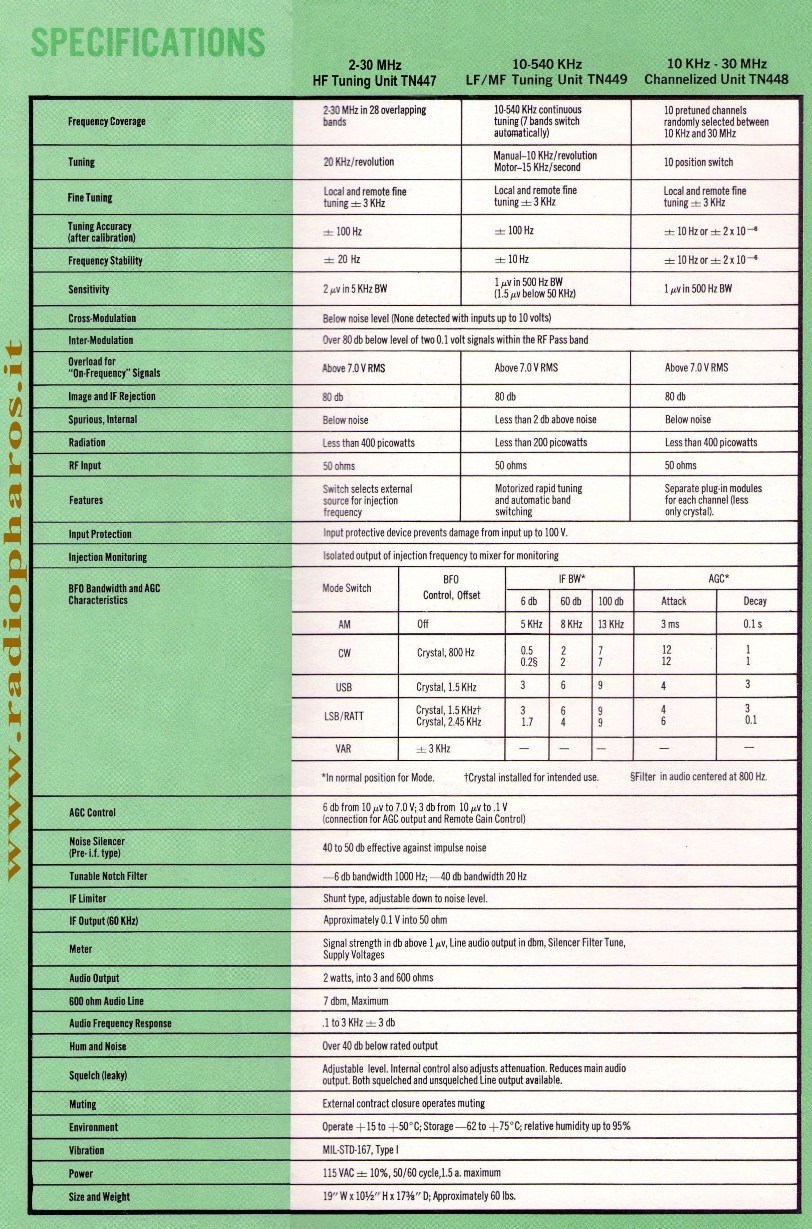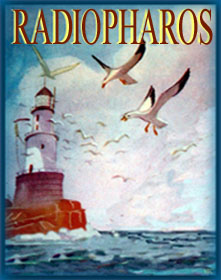
AN/URR-58
with TN-447 Tuning Unit
Over the years little information leaked about the
Squires-Sanders AN/URR-58 receiver. A few (apparently three) of these receivers
were built and, of course, this has not favored the spread on the surplus
market. Not long ago I found some more data in an old professional
magazine and recently the lucky acquisition of an original brochure has further
filled the gap. This allows describing, in sufficient detail (although some
technical aspects are still unknown), this
interesting and rare receiver.
INTRODUCTION
It was in 1967 when Squires-Sanders President D.F. Sanders was describing the
AN/URR-58(V) as a receiver that uses advanced front-end techniques to provide
unprecedented performance in dynamic range and linearity, consequently, in
resistance to desensitization, cross-modulation and inter-modulation. This
receiver was developed for the U.S. Coast Guard to allow reception of weak
signals under restricting shipboard conditions without interference from the
ship’s own transmitters or from other strong signals present in the operating
band. The performance in dynamic range and linearity of the URR-58 was the
result of a newly developed balanced double triode mixer which is linear over an
extremely wide range. The reception of on-frequency signals up to 7 Volts RMS without noticeable
distortion is indicative of the extremely wide dynamic range and linearity of
this design. At Squires-Sanders this mixing
circuit was considered better than the Beam Deflection tube mixer which was
pioneered for this purpose by the company itself.
FROM THE ORIGINAL BROCHURE
BRIEF TECHNICAL DESCRIPTION
Versatility in frequency coverage and tuning convenience was provided by the use
of a rugged Mainframe with interchangeable Plug-in Tuning Heads. The Mainframe
contained all intermediate frequency, detection, noise silencing, audio
frequency and related circuits in modular form. High quality printed circuit
boards and conservatively rated components assembled in sturdy, modular
sub-assemblies contributed to a high degree of reliability. Construction met
standard military specifications for shipboard equipment.
Ruggedized vacuum tubes were used in the Linear Mixers, in the IF and RF
Amplifiers but silicon semiconductors were the majority of the active devices.
Three Tuning Heads were available:
1° TN447 - HF/ 2—30MHz – in 28 Overlapping Bands
2° TN448 -10kHz—30MHz – Channelized Unit
3° TN449 -LF/MF/ 10—540kHz – Continuous Tuning (7 bands switched automatically)
Potentially a VHF head or ultra stable heads with digital tuning were
compatible with the basic design. The "heart" of the AN/URR-58 was its
Mixer or "True Product Mixer" as it was called at the Squires-Sanders. This
mixer was using a double triode tube type 6DJ8 (or, probably, the premium grade 6922), its
linearity was (and is) excellent and could handle large signals. It also offers
inherent IF rejection and greatly reduces the level of local oscillator voltage
appearing at the antenna input. In this
receiver it was preceded by a tube RF amplifier.
Squires-Sanders
had improved its basic technique (broadband pre-IF detection and gating) for elimination of impulse noise by including a delay
in the signal path and a tunable notching filter to prevent the silencer from
responding to large in-band signals. This system was used in the AN/URR-58. I don’t have a Block Diagram (or a
schematic) for this receiver but reading between the lines of the original specifications
and description one can
intuit that the AN/URR-58(V) was adopting a double conversion scheme (with
TN447) with a first IF at 1700 kHz and a second IF at 60 kHz. Also no
information is available regarding the Main Local Oscillator used in the TN447
Tuning Head. Was it an analogue synthesizer, a pre-mixing circuit or……?
FROM THE ORIGINAL BROCHURE

COMMENT
The performances in dynamic range and linearity of this receiver are really impressive! It was not very common, in that period, to see in the Specifications or Description of a receiver terms like Inter-Modulation (IMD) and Noise Sidebands (Phase Noise) of the Injection Oscillator. This confirms, if confirmation were needed, the high expertise of the Squires-Sanders technical staff and the principal objective of the Company which was the technical innovation. What does not shine in the Specifications of the AN/URR-58(V)/TN-447 is its Sensitivity that it's "only" 2µV in 5kHz BW at 10dB S+S/N. Was it a "conservative" value? The "steady" 80dB Image and IF Rejection shown in the Specifications casts doubt on the Conversion Scheme. This "steady" (and high) value of rejection is typical of Up Conversion design and if so this receiver utilized a triple conversion and not a double one.
|
|
CONCLUSION
At the AFCEA exhibition, in the summer of 1967, the AN/URR-58(V) made a fine show of himself in the Squires-Sanders stand. Not far away, in the National Radio Company stand, another receiver was on display; the R-1490/GRR-17. This completely solid state (transistors and ICs) receiver was developed for the U.S. Navy and to meet the restricting shipboard reception conditions it used a Parametric Mixer of high dynamic range (National Patent). But the Squires-Sanders Company, not to be outdone, responds with a two FET mixer (similar but less noisy than the double triode mixer) of really high performance. This mixer (Patented), designed by W.K. Squires, was exempt from some problems of the Parametric Mixer such as the use of a high level pumping oscillator, the need to use only an Up Conversion scheme with a high IF, etc. In which receiver did Squires-Sanders used (if ever) the two FETs mixer? This is a mystery! The investigation and search continue…….
www.radiopharos.it
Copyright© 2011--2021 All rights
reserved
Tutti i diritti riservati
1st
Issue - March 2011
Added Special Notes - April 2021
BACK

.jpg)
.jpg)
